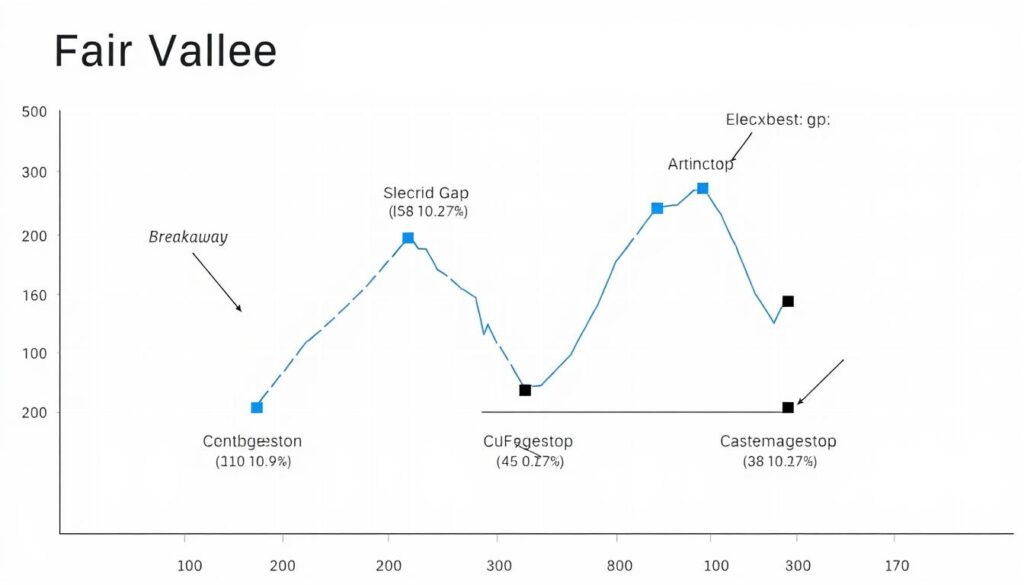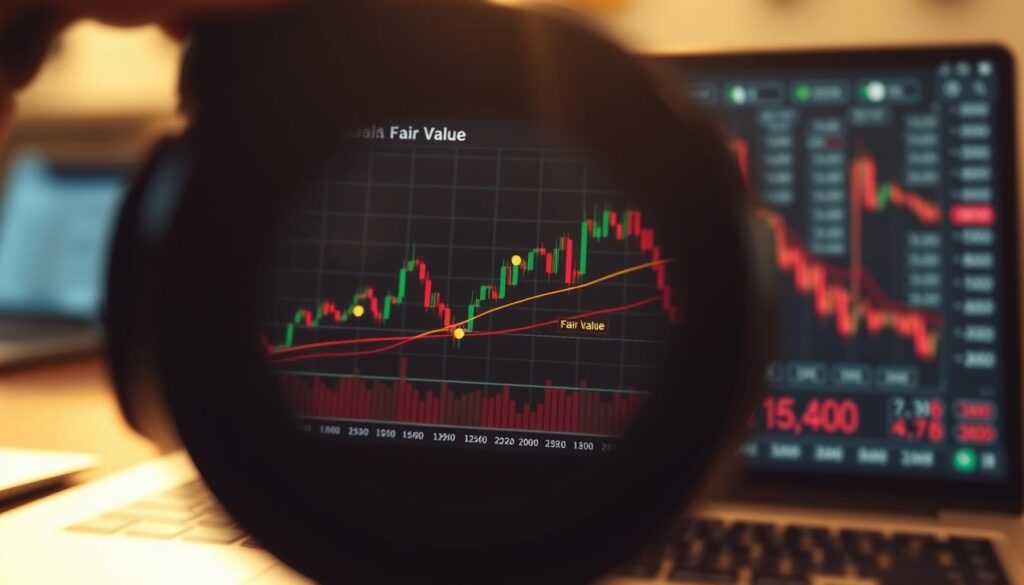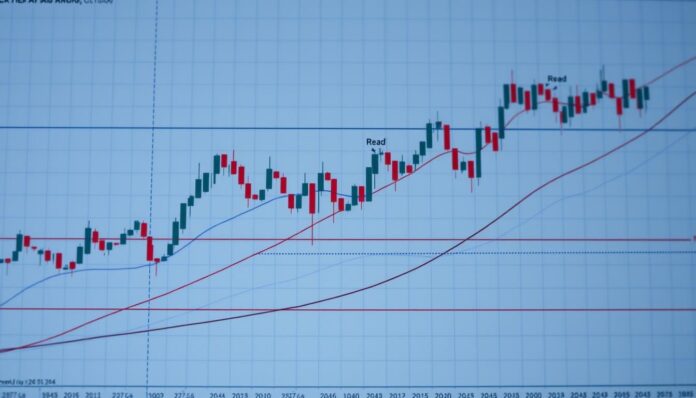At the heart of trading analysis lies the Fair Value Gap Definition, a key concept for spotting market opportunities. A What Is a Fair Value Gap in Trading? refers to price jumps when markets reopen far from their last closing price. These gaps signal shifts in supply and demand, helping traders identify trends or reversals.
Traders use this gap to gauge momentum. When prices skip a range without trading activity, it often reflects strong buyer or seller influence. Recognizing these gaps can guide entries, exits, and risk management strategies.
Key Takeaways
- The What Is a Fair Value Gap in Trading? answers why prices sometimes leap at market opens.
- The Fair Value Gap Definition helps traders assess whether gaps close or become trend catalysts.
- These gaps highlight imbalances between buyers and sellers, revealing market direction.
- Traders analyze gaps using charts to predict where prices might fill the gap or continue moving.
- Mastery of this concept improves decision-making and aligns with market realities.
Understanding Fair Value in Trading
At the heart of trading lies the concept of fair value. To grasp the Understanding Fair Value Gap, traders must first know what defines fair value itself. This foundational idea helps investors see beyond daily price swings and focus on what truly drives asset worth.
Definition of Fair Value
Fair value is the price an asset should have when all available information is considered. It’s calculated using factors like earnings, dividends, and economic data—not just current trading prices. For example, a stock’s fair value might differ from its market price because of temporary news or investor emotions. This gap between fair value and market price forms the basis of the Fair Value Gap in Finance.
Importance of Fair Value in Markets
Why does fair value matter? Here’s why:
- It ensures markets stay efficient by balancing buyers and sellers over time.
- Helps traders spot mispriced assets, creating opportunities to buy low or sell high.
- Promotes transparency by revealing when prices are inflated or undervalued.
Traders who track fair value can avoid common pitfalls. As one pro trader noted,
“Ignoring fair value is like sailing without a compass—you’ll miss your destination.”
What Causes Fair Value Gaps?
Market movements don’t occur in a vacuum. The Trading Fair Value Gap Explanation highlights three core triggers behind these price jumps. Let’s break down how these gaps form and why they matter for traders.
Market Dynamics and Sentiment
Emotions fuel many gaps. When fear spreads, sellers might panic, pushing prices below fair value gap definition ranges. Greed works the opposite way—optimism drives buyers to overshoot realistic valuations. Tools like the VIX volatility index often signal these shifts. For instance, a sudden surge in Bitcoin prices during a crypto rally shows how herd behavior amplifies gaps.
Economic Events and News Influence
“A Fed rate hike or earnings report can gap prices in minutes,” says trader Linda Raschke. “Traders react before data even hits screens.”
Surprise inflation reports or geopolitical events force rapid revaluations. Overnight news about supply chain disruptions, for example, might create a gap when markets reopen. These gaps reflect instant adjustments to new realities.
Market Inefficiencies
- Liquidity shortages: Thin trading volumes let prices jump without resistance
- After-hours news: Gaps often form when markets reopen post-closure
- Order imbalances: Sudden buy/sell surges overwhelm market mechanisms
Structural flaws like these let gaps emerge even without major news. Recognizing these triggers helps traders anticipate opportunities—or pitfalls.
Identifying Fair Value Gaps
Spotting a fair value gap requires a mix of technical tools and visual analysis. Here’s how traders decode these market clues without missing key signals.
Chart Patterns and Technical Analysis
Charts reveal gaps through visual breaks in price movement. Traders look for bullish or bearish gaps where prices open far from prior closes. Tools like candlestick charts highlight these spaces, showing where buyers or sellers dominate. For example, a sudden upward leap at market open might signal a bullish fair value gap. 
Common Indicators Used
Technical indicators act as calculators for fair value gap calculation. Traders combine:
- Volume analysis—high volume confirms gap validity.
- RSI—measures overbought/oversold levels near gaps.
- Fibonacci retracement—identifies support/resistance after gaps.
Recognizing Gaps in Price
Price charts tell stories. A gap appears as empty space between candlesticks, showing no trading occurred at those levels. For instance, a “breakaway gap” often signals strong momentum. Traders mark these zones to time entries or exits. Practice spotting these patterns daily to master fair value gap recognition.
How to Trade a Fair Value Gap
Turning theory into action requires clear steps. Here’s how to apply Fair Value Gap Trading Strategies effectively:
Strategies for Entering Trades
Choose between aggressive or measured approaches:
- Aggressive Entry: Buy/sell immediately after the gap opens, aiming to capitalize on momentum.
- Confirmation Entry: Wait for price action signals like candlestick patterns before committing.
Managing Risk and Stop Losses
Protect capital with these rules:
| Scenario | Stop-Loss Placement | Position Sizing |
|---|---|---|
| Gap Fills Quickly | Close to gap’s original level | Smaller initial positions |
| Gap Extends | Key support/resistance levels | Increased sizing with trailing stops |
Timing the Market
Follow these steps to time entries effectively:
- Watch for pre-market data (e.g., futures, options volume).
- Wait for volatility spikes post-open to confirm direction.
- Use moving averages (e.g., 50-day SMA) as reference points.
“Avoid chasing gaps—let the market confirm its direction first.”
Combining these steps with the Trading Fair Value Gap Explanation principles ensures disciplined execution. Practice with demo accounts before live trading.
The Role of Supply and Demand
Behind every fair value gap lies the invisible hand of supply and demand. These forces shape market movements and determine how gaps form and close.
Understanding Market Forces
When buyers outnumber sellers, prices rise—creating demand zones that fuel upward momentum. The Importance of Fair Value Gap analysis shines here, as sudden imbalances expose opportunities. Traders track order flow and market depth data to spot these shifts. For example, a surge in buy orders at a specific price level can push prices past resistance, leaving a visible gap. This imbalance often signals a temporary imbalance that traders exploit.
Supply and Demand Levels
Key levels act as gravitational pulls for prices. Here’s how to spot them:
- Identify supply zones where selling pressure peaks (e.g., after news releases).
- Locate demand zones where buyers step in aggressively (e.g., during dips).
- Monitor price clusters where gaps frequently form or close.
The Understanding Fair Value Gap process involves marking these zones on charts. Tools like volume profile charts or pivot points highlight critical levels. When a gap appears, traders watch whether prices return to these levels, confirming demand or supply dominance.
Common Mistakes in Trading Fair Value Gaps

Mastering Fair Value Gap Trading Strategies requires avoiding pitfalls that trap even experienced traders. Two critical errors often lead to losses: ignoring market context and skipping technical confirmations.
Overlooking Market Context
Traders sometimes focus solely on the gap itself while neglecting the bigger picture. For instance, a stock may open with a Fair Value Gap in Finance but decline if its industry sector is underperforming. Sentiment shifts, global events, or economic reports can invalidate assumptions about gap closure. Always assess trends in correlated markets and macroeconomic data before acting.
Ignoring Technical Indicators
Jumping into trades based on gaps alone is risky. Key technical signals like moving averages, RSI levels, or volume patterns must confirm the gap’s sustainability. Traders who overlook these may enter trades too early or miss reversal signs. For example:
- Low volume during a gap suggests weak momentum
- Oversold RSI readings may indicate a gap won’t close quickly
Pairing gaps with oscillator readings or trendlines strengthens Fair Value Gap Trading Strategies.
Successful traders remember: gaps are clues, not guarantees. Combine them with fundamentals and technicals to reduce risk and refine decisions.
The Impact of Fair Value Gaps on Trading Psychology
Trading What Is a Fair Value Gap in Trading? involves more than charts—it demands mental resilience. These gaps in price action expose traders to emotional extremes. Greed pushes for hasty entries, while fear freezes decision-making. Mastering Fair Value Gap in Finance psychology means recognizing how emotions distort logic.
Emotions and Decision-Making
Common pitfalls include:
- FOMO: Chasing gaps to “catch up” with market moves
- Confirmation bias: Seeing gaps where none exist
- Overconfidence: Overestimating predictive skills
Staying Disciplined in Trading
Build emotional control with these steps:
- Define entry/exit rules before the gap forms
- Use checklists to pause and assess choices
- Log trades to spot recurring emotional triggers
Tools like journaling and mentorship help traders separate emotions from strategy. Discipline turns gaps from stressors into opportunities.
Tools and Resources for Traders
Mastering fair value gap calculation demands the right tools and knowledge. Here’s how to access resources that simplify analysis and enhance trading decisions.
Trading Platforms and Software
Modern platforms offer tools to detect gaps and calculate their impact. Here’s a comparison of leading options:
| Platform | Key Features | Highlights |
|---|---|---|
| TradingView | Gap scanners, customizable alerts | Automated fair value gap calculation tools |
| MetaTrader 5 | Historical gap analysis | Backtesting gap strategies |
| eToro | Live market data | Real-time gap identification |
Educational Resources for Better Insights
Deepen your skills with these resources:
- Books: “The Gap & Go Trading Strategy” by Steve Burns
- Courses: Online modules on gap analysis at Udemy or Coursera
- Communities: Join forums like TradingView’s discussion boards
For traders exploring cryptocurrency CFDs, platforms like CFD trading guides provide practical insights. Mastering the importance of fair value gap concepts starts with hands-on practice using these tools.
Final Thoughts on Fair Value Gaps
Mastering fair value gaps demands combining knowledge with hands-on practice. Whether you’re analyzing charts or reacting to news, the principles of Understanding Fair Value Gap and applying Fair Value Gap Trading Strategies are essential. Let’s recap the path ahead.
Core Concepts to Remember
Remember, fair value gaps reflect market imbalances caused by news, sentiment, or inefficiencies. Spotting them requires studying price action, technical indicators, and supply-demand zones. Strategies like setting stop-losses and timing entries help manage risk. Psychology plays a role too—staying calm during gaps prevents costly mistakes.
Start Smart, Stay Consistent
Begin with free platforms like TradingView or Thinkorswim to simulate trades. Test strategies in demo mode before risking capital. Follow educational resources from MarketWatch or Investopedia to deepen your grasp of Understanding Fair Value Gap dynamics. Track real-time data on Bloomberg terminals to see gaps form in live markets.
Every gap is a learning moment. Review trades weekly, adjust strategies, and stay curious. Trading success grows with patience and disciplined practice. Keep these tools and lessons in mind as you refine your approach. The markets await—ready to apply what you’ve learned?

A writer, editor, and publisher with a knack for crafting informative articles.

